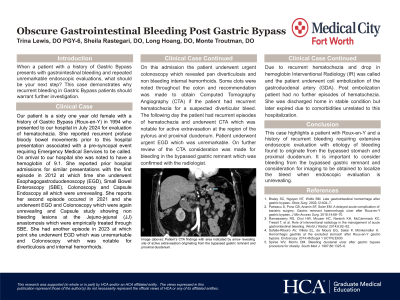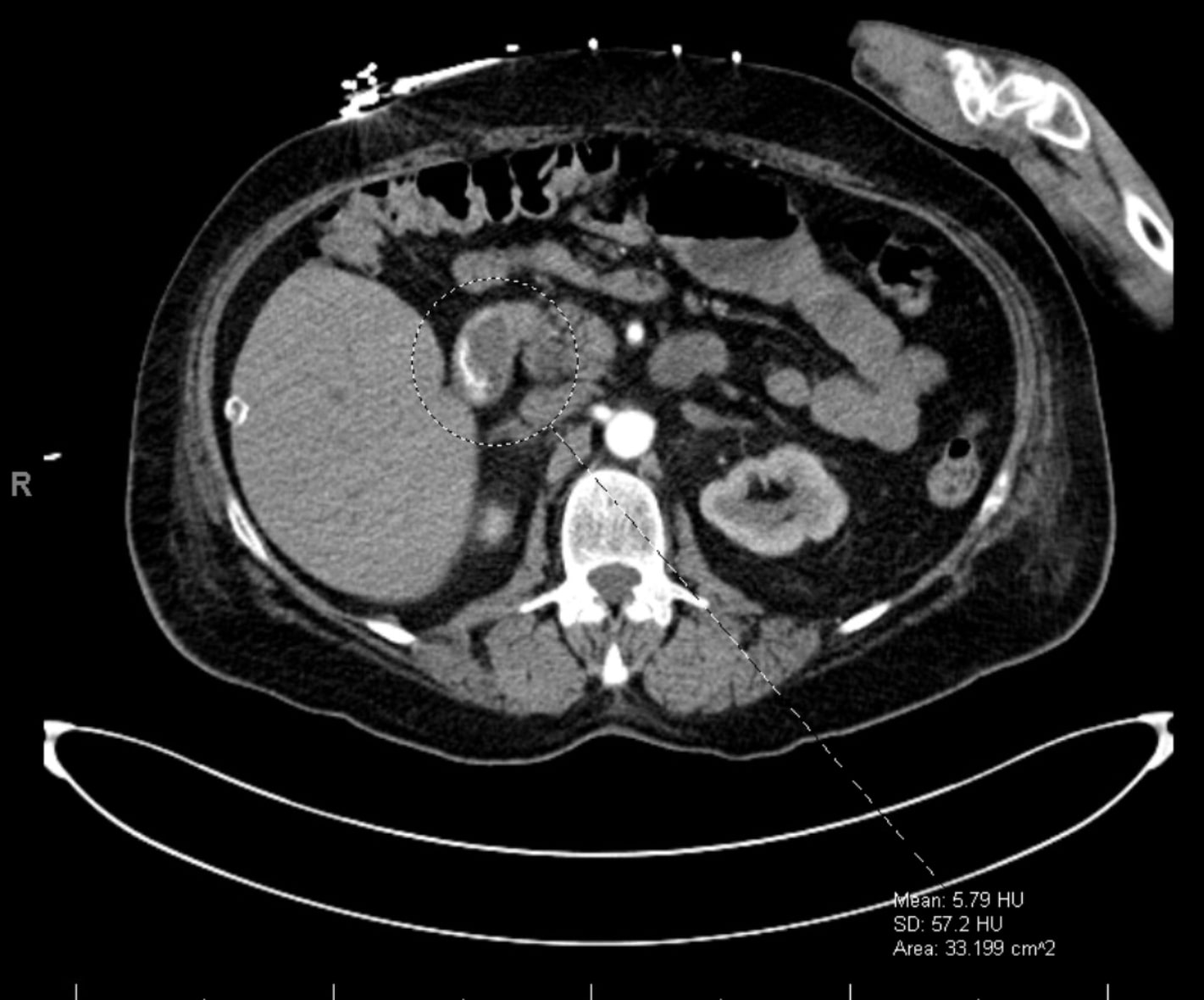Monday Poster Session
Category: GI Bleeding
P2502 - Obscure Gastrointestinal Bleeding Post Gastric Bypass
Monday, October 28, 2024
10:30 AM - 4:00 PM ET
Location: Exhibit Hall E

Has Audio

Trina Lewis, DO
Medical City Fort Worth
Fort Worth, TX
Presenting Author(s)
Trina Lewis, DO1, Sheila Rastegari, DO2, Long Hoang, DO3, Monte Troutman, DO4
1Medical City Fort Worth, Fort Worth, TX; 2John Peter Smith Hospital, Fort Worth, TX; 3HCA MCFW, Fort Worth, TX; 4University of North Texas Health Science Center, Fort Worth, TX
Introduction: When a patient with a history of Roux-en-Y presents with gastrointestinal bleeding and unremarkable endoscopic evaluation, what should be the next step? This case demonstrates why recurrent bleeding in gastric bypass patients should warrant further investigation.
Case Description/Methods: Our patient is a 61 year old female with a history of Roux-en-Y in 1994 who presented to the hospital for evaluation of hematochezia. Patient reported recurrent profuse bloody bowel movements prior to hospital arrival associated with a pre-syncopal event. She was noted to have hemoglobin of 9.1. She reported prior hospital admissions for gastrointestinal bleeding with first in 2012 at which time she underwent Esophagogastroduodenoscopy (EGD), Small Bowel Enteroscopy, Colonoscopy and Capsule Endoscopy all which were unrevealing. She had another episode in 2021 and underwent EGD, Small bowel Enteroscopy and Colonoscopy which were unrevealing and Capsule study showing non bleeding lesions at the JJ anastomosis which were empirically treated. She had another episode in 2023 at which point she underwent EGD which was unremarkable and Colonoscopy which was notable for diverticulosis and internal hemorrhoids.
On this admission patient underwent urgent colonoscopy which revealed pan diverticulosis and non bleeding internal hemorrhoids. Some clots were noted throughout the colon and recommendation was made to obtain CTA if patient had recurrent hematochezia for suspected diverticular bleed. The following day patient had recurrent episodes of hematochezia and underwent CTA which was notable for active extravasation at the region of the pylorus and proximal duodenum. Patient underwent urgent EGD which was unremarkable. On further review of CTA consideration was made for bleeding in the gastric remnant which was confirmed with the radiologist. Due to recurrent hematochezia and drop in hemoglobin interventional radiology was called and patient underwent embolization of the gastroduodenal artery (GDA). Post embolization patient had no further episodes of hematochezia. She was later discharged home in stable condition.
Discussion: This case highlights a patient with Roux-en-Y and a history of recurrent bleeding requiring extensive endoscopic evaluation with etiology of bleeding found to originate from the bypassed stomach and proximal duodenum. It is important to consider bleeding from the bypassed stomach and consideration for imaging to be obtained to localize the bleed when endoscopic evaluation is unrevealing.

Disclosures:
Trina Lewis, DO1, Sheila Rastegari, DO2, Long Hoang, DO3, Monte Troutman, DO4. P2502 - Obscure Gastrointestinal Bleeding Post Gastric Bypass, ACG 2024 Annual Scientific Meeting Abstracts. Philadelphia, PA: American College of Gastroenterology.
1Medical City Fort Worth, Fort Worth, TX; 2John Peter Smith Hospital, Fort Worth, TX; 3HCA MCFW, Fort Worth, TX; 4University of North Texas Health Science Center, Fort Worth, TX
Introduction: When a patient with a history of Roux-en-Y presents with gastrointestinal bleeding and unremarkable endoscopic evaluation, what should be the next step? This case demonstrates why recurrent bleeding in gastric bypass patients should warrant further investigation.
Case Description/Methods: Our patient is a 61 year old female with a history of Roux-en-Y in 1994 who presented to the hospital for evaluation of hematochezia. Patient reported recurrent profuse bloody bowel movements prior to hospital arrival associated with a pre-syncopal event. She was noted to have hemoglobin of 9.1. She reported prior hospital admissions for gastrointestinal bleeding with first in 2012 at which time she underwent Esophagogastroduodenoscopy (EGD), Small Bowel Enteroscopy, Colonoscopy and Capsule Endoscopy all which were unrevealing. She had another episode in 2021 and underwent EGD, Small bowel Enteroscopy and Colonoscopy which were unrevealing and Capsule study showing non bleeding lesions at the JJ anastomosis which were empirically treated. She had another episode in 2023 at which point she underwent EGD which was unremarkable and Colonoscopy which was notable for diverticulosis and internal hemorrhoids.
On this admission patient underwent urgent colonoscopy which revealed pan diverticulosis and non bleeding internal hemorrhoids. Some clots were noted throughout the colon and recommendation was made to obtain CTA if patient had recurrent hematochezia for suspected diverticular bleed. The following day patient had recurrent episodes of hematochezia and underwent CTA which was notable for active extravasation at the region of the pylorus and proximal duodenum. Patient underwent urgent EGD which was unremarkable. On further review of CTA consideration was made for bleeding in the gastric remnant which was confirmed with the radiologist. Due to recurrent hematochezia and drop in hemoglobin interventional radiology was called and patient underwent embolization of the gastroduodenal artery (GDA). Post embolization patient had no further episodes of hematochezia. She was later discharged home in stable condition.
Discussion: This case highlights a patient with Roux-en-Y and a history of recurrent bleeding requiring extensive endoscopic evaluation with etiology of bleeding found to originate from the bypassed stomach and proximal duodenum. It is important to consider bleeding from the bypassed stomach and consideration for imaging to be obtained to localize the bleed when endoscopic evaluation is unrevealing.

Figure: CTA revealing active extravasation at region of pylorus and proximal duodenum
Disclosures:
Trina Lewis indicated no relevant financial relationships.
Sheila Rastegari indicated no relevant financial relationships.
Long Hoang indicated no relevant financial relationships.
Monte Troutman indicated no relevant financial relationships.
Trina Lewis, DO1, Sheila Rastegari, DO2, Long Hoang, DO3, Monte Troutman, DO4. P2502 - Obscure Gastrointestinal Bleeding Post Gastric Bypass, ACG 2024 Annual Scientific Meeting Abstracts. Philadelphia, PA: American College of Gastroenterology.

